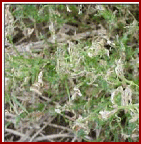|
The clover
leaf weevil occurs throughout much of the United States, wherever
clover and alfalfa are grown. It is often confused with the alfalfa
weevil, one of the major insect pests of alfalfa. Cloverand alfalfa
are the primary hosts of the clover leaf weevil, but it also may infest
corn, goldenrod, Jerusalem artichoke, snap bean, timothy, and wheat.
Description
Clover leaf weevil adults are approximately 5 to 10 mm long. They
are brown colored with small gray, brown, and yellow scales giving
it a mottled and striped appearance. Newly laid eggs are pale yellow,1
mm long and gradually darken to black as they near hatching. Larvae
are green with a white strip down the center of their backs. The white
stripe is bordered by pink or red smudges. Larvae have a brown head
and reach 12 to 13 mm in length. The pupa is 5.5 to 7 mm long, yellow-green
in color, and is enclosed in a cocoon.
The clover leaf weevil can be confused with the alfalfa weevil.
Larvae of both species are similar, but have distinct differences
in appearance. Alfalfa weevil larvae are also green with a white stripe
down their backs, but have no pink coloring. Head capsules of alfalfa
weevil larvae are black. Adult alfalfa weevils are small brown beetles
that have adistinctive dark, narrow stripe that extends down their
back and about one quarter of the size of an adult clover leaf weevil.
 |
 |
 |
 |
 |
|
Clover
leaf weevil larva
M. Montgomery,UI Extension
|
Alfalfa
weevil larva
|
Clover
leaf weevil cocoon
M. Montgomery,UI Extension
|
Clover
leaf weevil pupa
M. Montgomery,UI Extension
|
Clover
leaf weevil adult
OU Biological Survey
|
|
| Life
Cycle
There is only one generation each year. The adult, which is present
from July through October, lays its eggs in stems, on stalks, or
near the crowns of plants. The small green larvae hatch in the fall
and spend the winter in the soil. Most eggs will hatch in the fall,
but some will overwinterand hatch in the spring. Larvae climb the
plant and feed on foliage. The clover leaf weevil is nocturnal,
feeding atnight, and hiding during the day in the crown of the plant
and in the debris on the ground. On dark, cloudy days, however,
they may also feed throughout the day. They become full grown in
late May and June, when they pupate in the soil debris. Adults emerge
from May to July and feed for a short period of time before becoming
inactive. Beetles resume activity in the fall and lay eggs. |
Click
on image for a larger version

Clover
leaf weevils at base of alfalfa plants.
M. Montgomery,UI Extension |
|
|
Injury
Adult clover leaf weevils do not generally cause
economic damageto alfalfa. Injury caused by larvae is similar to
that caused by the alfalfa weevil. Injury may occur very early in
the spring, prior to when alfalfa weevils are noticed. Most feeding
by larvae occurs in late March and the first 3 weeks of April. Larvae
skeletonize the leaves of the plants, leaving them ragged and in
some cases almost completely defoliating the whole plant. The effect
is the same as though newly forming leaves were removed from the
plant each day. In some cases the plants may die. Under normal growing
conditions, however, the clover usually recovers from injury when
weevil numbers are moderate.
|
Click
on image for a larger version

Severe feeding by clover
leaf weevil
M. Montgomery,UI Extension
|
|
During
a cool spring when growing conditions are unfavorable, this defoliation
may seriously stunt clover growth. Damage is usually most severe
in fields with a heavy residue cover. The larvae feed throughout
the day beneath residue, and the plants, shaded from the sun, do
not have an opportunity to grow away from the damage.
Scouting
Procedure
To
monitor fields for clover leaf weevil, examine the crowns of 20
plants in five different areas of the field.
|
Click
on image for a larger version

Clover leaf weevil
killed by a fungal disease |
Management
An insecticide treatment may be warranted if five or more larvaeper
crown are found and leaf damage is evident during early to mid-April.
Late March or early April insecticide treatments will prevent most
damage since most larval feeding occurs during that time. However,
insecticide applications are rarely needed. Clover leaf weevil populations
usually stay well below their economic injury level. |
| They
are very susceptible to a fungal disease which favors cool and wet
springs and can spread rapidly through a weevil population. Infected
larvae turn yellow and then brown. Be sure to examine larvae when
scouting to check for diseased clover leaf weevils. Clover leaf weevil
densities may decline rapidly after diseased larvae are observed in
the field. |
Authors:
Kelly A. Cook (kcook8@uiuc.edu)
Susan T. Ratcliffe(sratclif@uiuc.edu)
Michael E. Gray (megray@uiuc.edu)
Kevin L. Steffey(ksteffey@uiuc.edu) |



